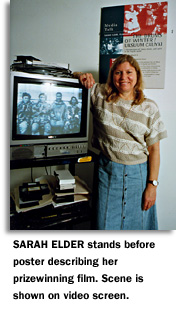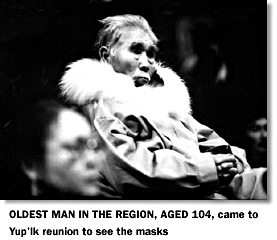 This has been one of Elder's shining seasons.
This has been one of Elder's shining seasons. 
By PATRICIA DONOVAN
News Services Editor
 This has been one of Elder's shining seasons.
This has been one of Elder's shining seasons.
First, after a series of major film awards, "Uksuum Cauyai: The Drums of Winter," her classic documentary about Alaska's Yup'ik Eskimos, last summer swept the three top prize categories at the prestigious 1996 Native Americas International Film Festival in Santa Fe. Co-produced with Leonard Kamerling, the film documents the rich tradition of the Yup'iks' music, dance and spiritual world and attempts by missionaries to suppress them. The film received prizes for best documentary feature, best documentary direction and best cinematography.
Elder served recently as media consultant for "Agayuliyararput (Our Way of Making Prayer): The Living Tradition of Yup'ik Masks," a major international exhibition mounted by the Anchorage Museum of History and Art, the Smithsonian Institution and the National Endowment for the Humanities.
The exhibition showcases hundreds of mystical masks, many of them legendary in their power and beauty, produced by the Yup'ik people during the last century and taken from them by traders and missionaries.
 It opened in March at the Smithsonian's National Museum of the
American Indian in New York City with a screening of "The Drums of
Winter" and a lecture by Elder about her work with the Yup'ik. The
exhibition will continue through Aug. 17 and then travel to Washington,
Seattle, Juneau and Fairbanks.
It opened in March at the Smithsonian's National Museum of the
American Indian in New York City with a screening of "The Drums of
Winter" and a lecture by Elder about her work with the Yup'ik. The
exhibition will continue through Aug. 17 and then travel to Washington,
Seattle, Juneau and Fairbanks.
Elder now is making a film about the Yup'iks' reunion with the masks featured in the exhibit. In January, she flew to Toksook Bay, a tiny Yup'ik village on the shores of the Bering Sea to film the opening of the exhibit, which then went to New York City. This is the region where the masks were produced.
Despite her deep and long experience with Alaska's native culture, Elder said nothing had prepared her for the response of the Yup'ik upon being reunited with the masks.
 "It was very emotional," she said. "Everyone spoke in hushed
tones. The children were reverential. The masks were produced at a time
when the Yup'iks had little contact with white people. Very few
villagers or anyone else had ever even seen the masks.
"It was very emotional," she said. "Everyone spoke in hushed
tones. The children were reverential. The masks were produced at a time
when the Yup'iks had little contact with white people. Very few
villagers or anyone else had ever even seen the masks.
"But the elders remembered them from their childhood," she added. "When they handled and stroked them, floodgates of memory were opened.
"The old men teared up. They began to recount stories of their childhood, of seeing the grand masked ceremonies with shamans. Some even remembered the men who made the masks they held in their hands. They remembered stories they had been told as very little children. These were stories that we had never heard before, even those of us who had been documenting this culture for years. Their past came alive in new ways. It was amazing and very moving, both a joyous and bittersweet experience for the people.
"But it was also an exceptionally joyous time," Elder said. "Dancers and spectators from 12 villages flew in on bush planes for the opening. They danced for four days and nights! Nothing like this had ever happened before. Even a 104-year-old man, the oldest man in the region, came to see the masks.
Elder noted, "For 25 years I've searched for this missing link in the spiritual and creative history of the Yup'ik people. Finally, on that day in Toksook Bay, I found it. It was astonishing and I had the good fortune to be filming it all. I think it was the greatest experience of my life."
She recounted how, long ago, the Yup'ik danced and drummed through the long winter nights wearing the fragile, intricately designed masks of driftwood, bone, fur and feathers, some with holes through which animals were believed to come into the world. Many were carved by shamans to represent their dreams and visions.
 The dancers would kneel or stand, their feet very still, their upper
bodies rocking and twisting as their arms arced through the air in the
"heathen" attitude anathema to the missionaries who described them. In
dance the Yup'ik celebrated the abundant harvests and hunts that had
carried them through the winter. In dance they expressed hope and
supplication to the spirit world to help them live what Elder calls "a
right and generous life."
The dancers would kneel or stand, their feet very still, their upper
bodies rocking and twisting as their arms arced through the air in the
"heathen" attitude anathema to the missionaries who described them. In
dance the Yup'ik celebrated the abundant harvests and hunts that had
carried them through the winter. In dance they expressed hope and
supplication to the spirit world to help them live what Elder calls "a
right and generous life."
Although the Yup'ik traditionally burned the masks after ceremonial use, their intricate carvings and fanciful expressions of animism attracted the attention of traders who carried away thousands of them from the 1890s to the 1940s and later sold or bequeathed them to museums and individual collectors.
The exhibition's curator, anthropologist Ann Fienup-Riordan, located about 2,000 of them in museums and private collections throughout the world, including many in mid-century French Surrealist collections. From these she selected 200 for presentation.
Some of the masks are three-dimensional representations of animals, sea creatures and holy spirits: beavers and loons, caribou and walrus, animistic powers to be propitiated. Some were created in pairs or in threes-similar-looking, but not identical companion masks depicting contrasting themes or related objects. Many have feather halos (the Yup'ik call them "rings of the cosmos"), others have appendages-arms, legs, wings, heads. They are witty, often startling.
While growing up, Elder said she was cautioned to avoid working in a field that traditionally was a male domain.
She defied the odds and today, although still one of the few women in her field, has received dozens of major international film awards, represented the United States in virtually all major international ethnographic film festivals over the past 20 years and has been an organizer and consultant to important traveling exhibitions, including the annual Margaret Mead Film Festival sponsored by New York City's American Museum of Natural History.
In 1995, Elder was invited to show the body of her work at the Lumi�re Institute in Lyon, France, for the centennial celebration of the Lumi�re brothers' invention of cinema. The same year, she won the award for Best Cultural Film at the international Northern Lights Film Festival, competing against films from Russia, Japan, Sweden, Canada, Denmark and other nations.
 Among her 11 other award-winning documentary films are "Every Day Choices: Alcohol and an Alaskan Town" (1985), winner of the Award
for Excellence from the American Anthropological Association); "On the
Spring Ice" (1976), first-prize winner at the American Film Festival and
of the 1977 CINE Golden Eagle Award, and "Overture on Ice" (1983), which
won the first prize in the Sinking Creek Film Festival and special
honors from both the National Endowment for the Arts and the Alaska
State Legislature.
Among her 11 other award-winning documentary films are "Every Day Choices: Alcohol and an Alaskan Town" (1985), winner of the Award
for Excellence from the American Anthropological Association); "On the
Spring Ice" (1976), first-prize winner at the American Film Festival and
of the 1977 CINE Golden Eagle Award, and "Overture on Ice" (1983), which
won the first prize in the Sinking Creek Film Festival and special
honors from both the National Endowment for the Arts and the Alaska
State Legislature.
Elder served as jurist and visiting artist at the 1995 Big Muddy Film Festival and has been a film and video consultant for dozens of indigenous cultural organizations in the Pacific Rim and North America. Her films have been featured in nearly 100 special film exhibitions in the U.S., Asia and Europe and she has received many state, federal and foundation grants in support of her work.
Presently, Elder is looking for interested UB faculty to join with her in establishing a University at Buffalo Center for Media Culture and History, an interdisciplinary program that will link faculty who "in some way use photography, film, documentary text and audio recording to bring their work to the public.
"Media has a place in the arts," she said, "but it is also a powerful force in the way society knows and understands itself. It has a very important place in the critical examination and documentary study of societies and cultures, our own included." Interested faculty may contact Elder in the Department of Media Study or at selder@acsu.buffalo.edu.